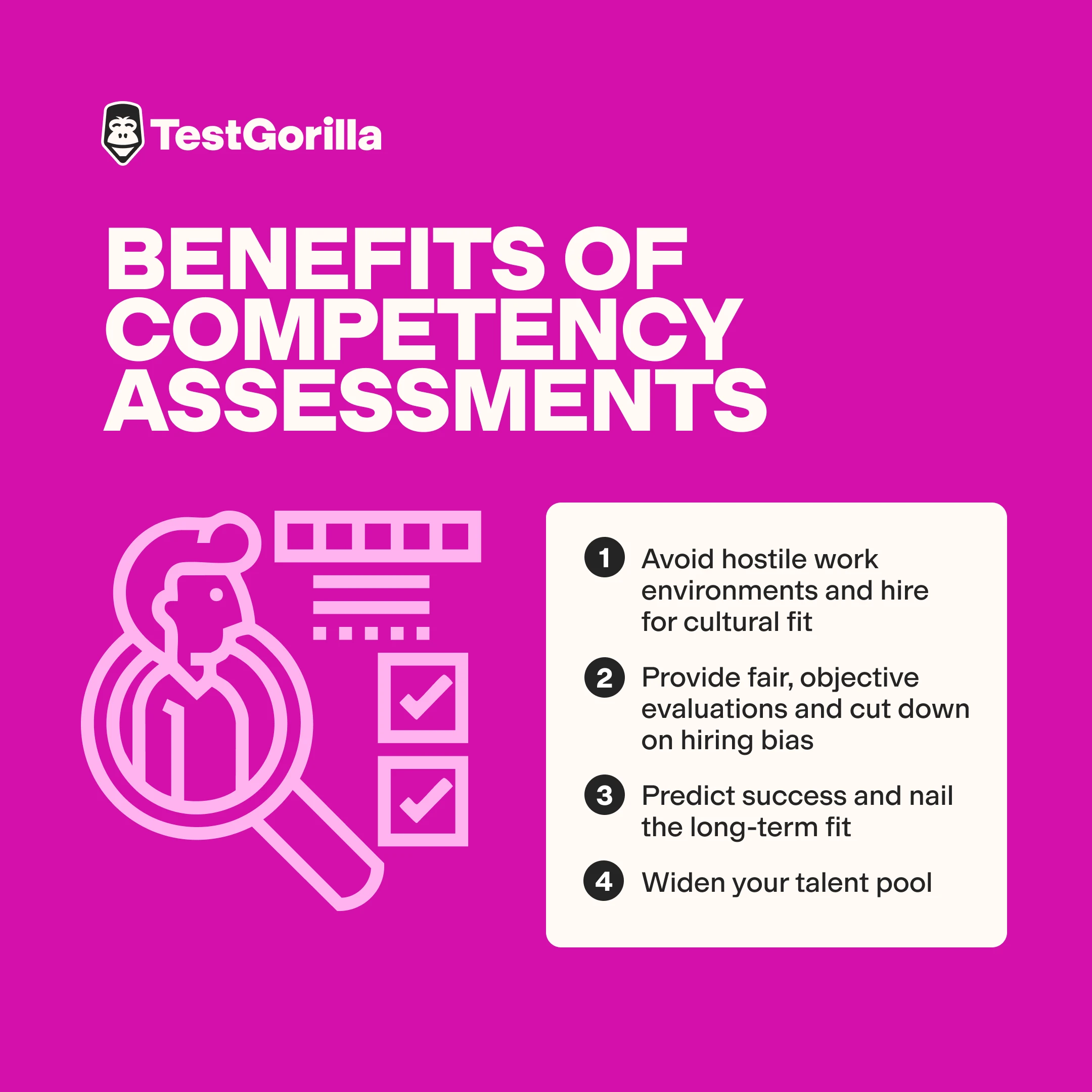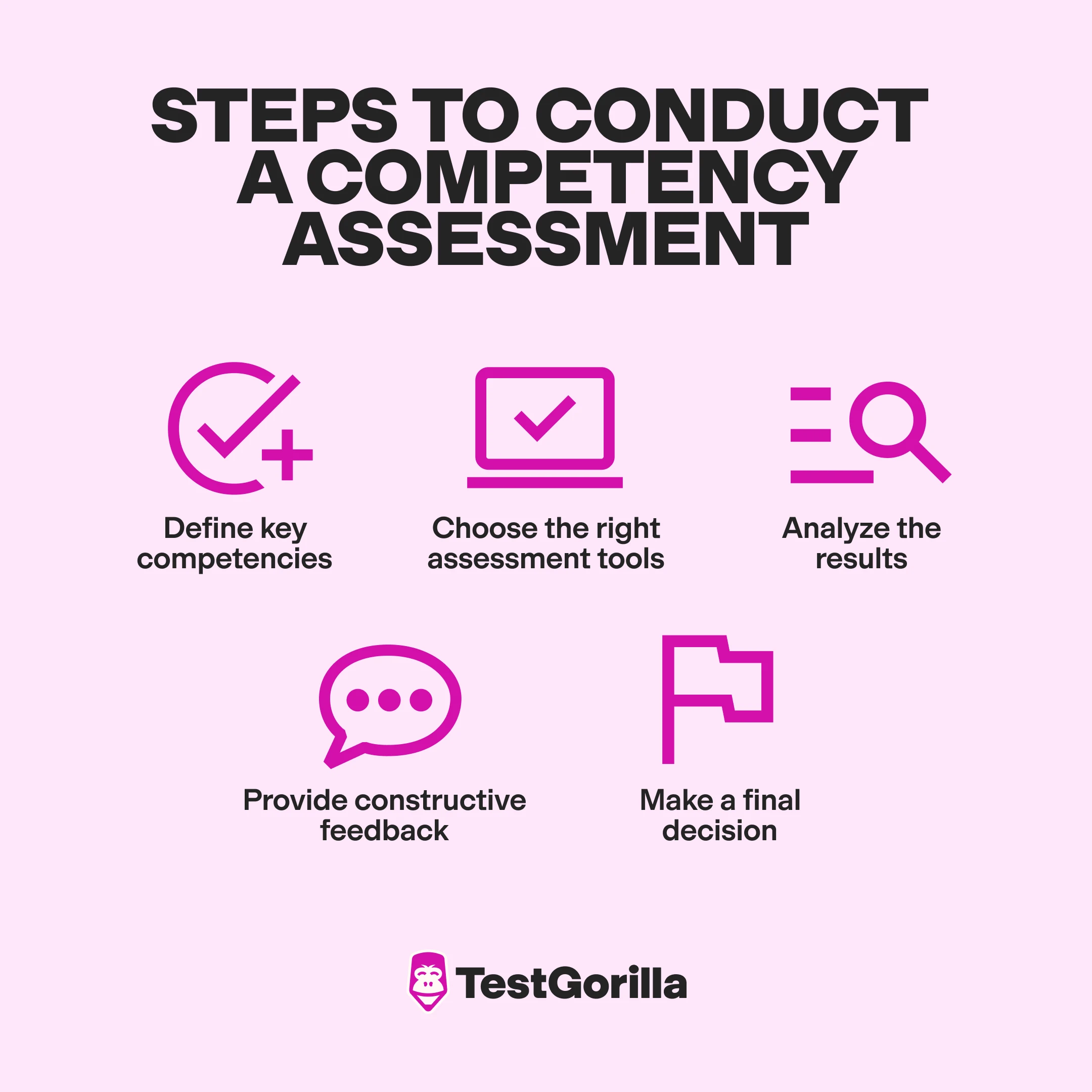When you’re hiring new talent, it can be challenging to get past what’s on paper. Resumes are polished and interviews can be rehearsed, leaving you wondering if a candidate really has what it takes.
Make the wrong hire, and you risk employee turnover and lower productivity, which can hurt your organization's pockets. So how do you ensure your candidates have the skills and behaviors that truly matter for success in the role you’re hiring for?
That’s where competency assessments come in. They give you a deeper look into what a candidate can do beyond their experience. This article shows how to conduct competency assessments to hire people who will thrive in your company culture.
Key takeaways on how to conduct competency assessments
Define key competencies: Identify the essential skills for the role by analyzing day-to-day tasks and collaborating with your team to ensure alignment with job requirements and company culture.
Use the right tools: Platforms like TestGorilla let you create custom assessments tailored to the competencies you’re after, ensuring you evaluate what truly matters for success.
Analyze the results: Once assessments are completed, review the data to compare candidates against the required skills, making decisions based on objective insights, not gut feelings.
What is a competency assessment?
A competency assessment tests your candidate’s skills, knowledge, and behaviors to see how well they meet the requirements of a specific role in your team. It forms part of a skills-based hiring approach that tells you much more about a candidate than what’s on their resume.
Some common types of competency assessments include:
Competency assessments are usually scored with methods like rating scales, rubrics, or pass/fail setups. These methods help you see how a candidate’s skills stack up against the role, and for online tests, the scoring is often automatic.
Why competency assessments are important
Unlike traditional hiring methods, which rely heavily on impressive resumes and interviews, competency assessments dig deeper. According to StandOut CV’s survey, approximately 64.2% of Americans have, at some point, lied about personal information, skills, experience, or references on their resumes. Competency assessments help you weed out these applicants.
Competency assessments also show whether candidates have the right soft skills, like communication, for the role. This may seem minor, but 89% of employers have said their failed hire lacked soft skills. If candidates can’t communicate with their teammates well, this can lead to misunderstandings, poor teamwork, and lower productivity.
The best insights on HR and recruitment, delivered to your inbox.
Biweekly updates. No spam. Unsubscribe any time.
The benefits of conducting a competency assessment
Competency assessments play a huge role in creating a healthier, more productive workplace. Here’s how they benefit your organization:
1. Avoid hostile work environments and hire for cultural fit
Competency assessments do more than just tell you what a candidate can do—they show you how they behave and mesh with others. You can use TestGorilla’s DISC Personality test, for example, to see how your candidates might behave in group settings. This way, you’re less likely to hire someone who’ll mess with the team dynamic or cause drama. Plus, you’ll be bringing on people who fit with your company’s values and culture.
2. Provide fair, objective evaluations and cut down on hiring bias
Competency assessments focus on real skills instead of first impressions or gut feelings. This cuts down on bias and makes the hiring process fairer, leading to a more diverse and capable team.
A more diverse business will likely perform 1.32 times better than one lacking in that department.
3. Predict success and nail the long-term fit
With competency assessments, you’re not just guessing who might do well—you’ve got real data to back up your hiring decision. It helps you avoid bad hires and find people who will thrive in the role long term.
Why is this such a big deal? It’s expensive. Replacing a bad hire can cost you 29% of an employee’s annual pay. That means if on average, your employees earned $75,000 annually, it would cost you an additional $21,750 to replace them that year.
In TestGorilla’s 2025 survey on the state of skills-based hiring, 2 in 3 employers reported fewer mis-hires by incorporating skills tests.
4. Widen your talent pool
By focusing on actual skills instead of just ticking boxes on traditional qualifications, you’ll bring in a wider range of candidates. This means you aren’t missing out on fresh talent with different perspectives and ideas who can help push your company forward.
How to conduct a competency assessment
To get the most out of competency assessments, you need a clear, structured approach. Here’s how to do it effectively:
1. Define key competencies
Start by nailing down the skills that are essential for the role. This could be anything from technical know-how to problem-solving abilities or even softer skills like leadership or communication.
Make sure the skills you choose match both the job requirements and your company culture. This way, you’re not just hiring for technical fit—you’re bringing in people who’ll thrive in your work environment.
Top tip: Break the role down by looking at the day-to-day tasks and what skills are must-haves to get them done right. Chat with your team to figure out which competencies matter most for them. Once you’ve got your list, focus on those skills in your assessments.
2. Choose the right assessment tools
Choosing the right tools is key. A platform like TestGorilla lets you create custom assessments that assess the skills you’re after. Whether it’s technical ability or leadership qualities, you can test for exactly what matters.
For example, if you’re hiring a marketing lead, you could use TestGorilla’s:
Branding strategy test, to see their brand development skills.
Marketing Analytics test to test their marketing data analytics skills.
Leadership and People Management test to see their team motivation and leadership skills.
What if one candidate crushes the leadership and strategic part but scores lower on marketing analysis? Let’s say leadership skills carry more weight than marketing analytics in your assessment. The candidate’s test scores can help you decide if their skills are good enough to lead the team successfully even though their marketing analytics skills aren’t the best.
Or perhaps you need someone who is strong in both areas to lead the team effectively? You can select another candidate that has the balanced scores you’re looking for.
3. Analyze the results
Once the assessments are done, take a close look at the results. Check how well each candidate stacks up against the skills you defined. Tools like TestGorilla give you detailed reports, making it easier to compare candidates and see who’s the best fit for both the role and the team.
For example, when hiring a social media manager, run a competency assessment to test for written communication, problem-solving, and critical thinking skills. If a candidate nails the problem-solving and critical thinking parts but falls short on communication, use their scores to decide if they’re still a good fit.
With TestGorilla’s detailed report, you can easily see how they compare to current team members and decide whether their creative skills outweigh the need for strong data analysis or if another candidate is a better fit overall.
Further reading: How to hire a professional social media manager: a detailed guide
4. Provide constructive feedback
Even if someone doesn’t make the cut, giving them useful feedback goes a long way. It keeps your employer brand strong and helps candidates grow. This way you’re creating a hiring process that’s fair and supportive.
Tip: You might say something like this to the unsuccessful candidate: “Thanks for taking the time to complete the assessment! You showed great problem-solving and critical thinking skills, but we’re looking for someone with stronger written communication skills for this role. We appreciate your effort and encourage you to keep developing in that area.”
5. Make a final decision
With all the insights from the assessments, you’re ready to make an informed decision. The next step is to compare these results with your team’s current needs. Make sure your candidates have the right skills, complement your team’s strengths, and fill any skill gaps.
For example, you’re hiring a content strategist, and the competency assessment reveals one candidate is a perfect match for your company’s creative needs but struggles with project management. Another candidate has strong organizational skills but lacks creativity.
Based on their scores, you decide to move forward with the first candidate because their creative vision aligns better with your team’s values, and you can provide extra support to develop their project management skills.
Start hiring skilled candidates with TestGorilla
Competency assessments are your solution to more accurate, objective, and inclusive recruitment. And tools like TestGorilla can help you ensure your hiring decisions are based on real, meaningful data. Our library of 350+ research-backed tests enables you to measure candidates in all kinds of ways, including competency, behaviour, personality, and cultural fit.
A skills-based hiring approach also contributes to a more inclusive, supportive work environment, as only those who truly align with your company’s values are brought on board. This can reduce friction and hostility in the workplace, creating a more cohesive and positive team dynamic.
Ready to take the guesswork out of hiring? Start using TestGorilla today. Book a free live demo and sign up for your free plan to get started.
FAQs
What questions are asked in a competency assessment?
A few questions commonly asked in a competency assessment include:
How do you handle tight deadlines?
Can you describe a time you solved a challenging problem?
How do you prioritize tasks in a busy environment?
How do you approach teamwork on large projects?
Can you give an example of a time you took initiative?
How do you manage conflicts with coworkers?
Can you describe a time you successfully led a team?
How do you adapt to unexpected changes at work?
What are the 3 levels of competency?
The three levels of competency are:
Basic – Your candidate has the basics down and can handle simple tasks with some guidance.
Intermediate – Candidates can do the tasks on their own and consistently do those tasks well.
Advanced – The candidate is a pro, handling complex tasks solo and helping others improve.
You've scrolled this far
Why not try TestGorilla for free, and see what happens when you put skills first.





















